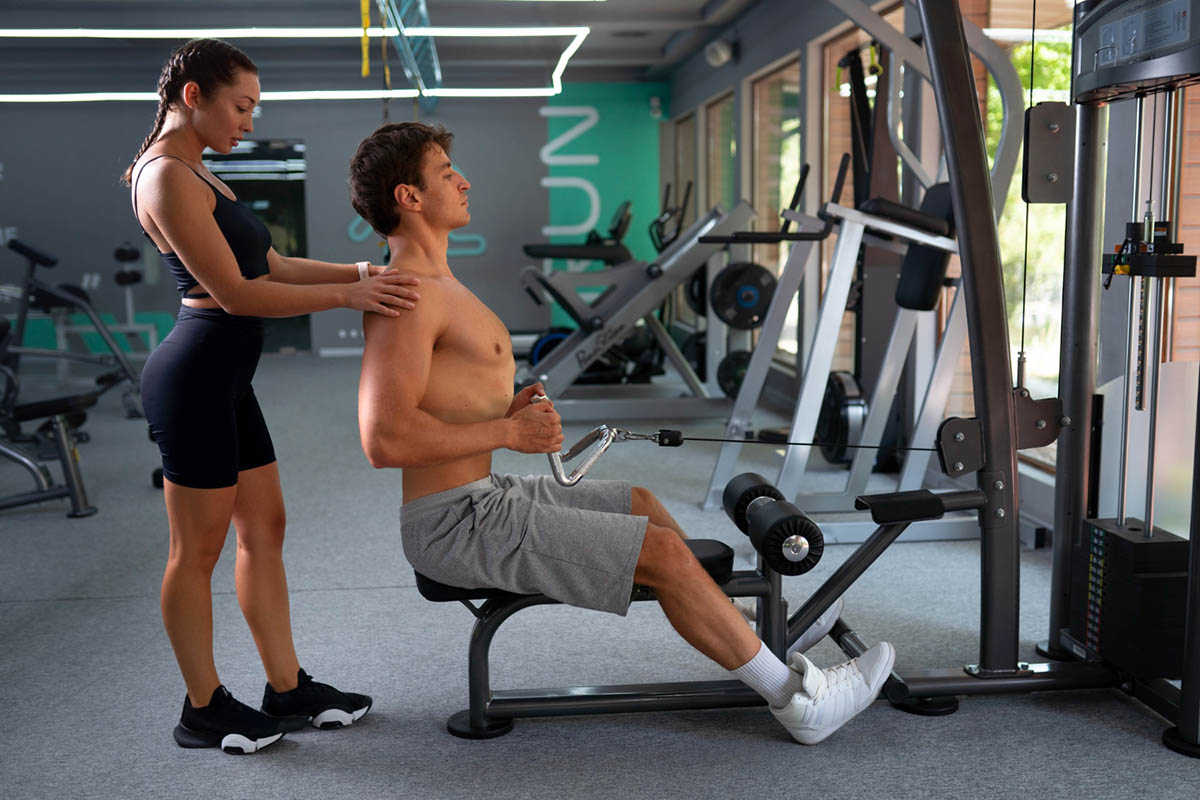
Cervical radiculopathy, also known as a pinched nerve, occurs when the nerves in the neck are compressed. This condition can result in pain, numbness, and weakness that radiates down the arm.
Luckily, specific exercises designed to alleviate cervical radiculopathy can offer significant relief. When combined with professional guidance, these exercises can help manage symptoms, improve mobility, and enhance overall neck health.
This article will explore seven specific exercises designed for people with cervical radiculopathy. These exercises target the affected areas to reduce discomfort and improve the neck’s range of motion. By incorporating these exercises into your daily routine under the supervision of a healthcare professional, you can experience substantial improvements in managing the symptoms of a pinched nerve in the neck.
Common Causes of Cervical Radiculopathy
Cervical radiculopathy typically arises from:
- Herniated Discs: Intervertebral disc material that slips out of place can press on nearby cervical nerve roots, causing nerve impingement and acting as ineffective shock absorbers.
- Degenerative Disc Disease: Age-related wear and tear on the spinal intervertebral discs, often leading to degenerative disc disease pain.
- Spinal Stenosis: Narrowing of the spinal canal that compresses the nerves, often leading to spinal cord compression and foraminal narrowing, particularly in the lumbar spine. Herniated disk material can also contribute to this narrowing.
- Injuries: Trauma or sudden movements that strain the neck, causing nerve root irritation, spinal cord injury, and potential damage to the spinal canal.
Symptoms of Cervical Radiculopathy
Individuals with cervical radiculopathy may experience:
- Sharp or burning axial neck pain, along with radicular pain in the shoulder or arm, particularly when the neck is not in a neutral position. Numbness or tingling sensations in the upper extremities.
- Sensory symptoms such as numbness or tingling sensations in the upper extremities
- Muscle weakness in the arm or hand.
- Reduced reflexes in the arms.
According to WebMD, cervical radiculopathy, commonly known as a pinched nerve, affects approximately 83 out of every 100,000 people annually, with the condition being more prevalent in individuals over the age of 50, as indicated by a population-based study.
Benefits of Physical Therapy for Cervical Radiculopathy

Pain Relief and Improved Mobility
Physical therapy exercises for cervical radiculopathy are designed to alleviate nerve impingement and improve the active range of motion in the neck and shoulders, supported by a comprehensive physical therapy program. These neck exercises help reduce inflammation and pressure on the affected nerves, thereby alleviating sensory symptoms. In cases where conservative measures like nonsteroidal anti-inflammatory drugs are insufficient for managing acute pain, transforaminal steroid injections, selective nerve root blocks, or epidural steroid injections may be considered for targeted pain relief and inflammation reduction. However, there needs to be more evidence to support their long-term effectiveness in addressing manual dexterity and enhancing overall quality of life.
Strengthening Neck Muscles
Strengthening the muscles around the neck provides better support to the cervical spine, reducing the risk of further injury and helping to manage existing pain. This includes addressing muscle weakness, neck muscle endurance, and neck disability. Manual therapy may also be incorporated for additional manual dexterity relief.
Preventing Future Episodes of Neck Pain
Regularly performing exercises for cervical radiculopathy can prevent future episodes of neck pain by maintaining flexibility and strength in the neck and shoulder muscles.
Personalized Treatment Plans
Physical therapists at WildHawk Physical Therapy create personalized treatment plans tailored to each patient’s specific needs and condition, ensuring optimal recovery and pain management through a customized physical therapy program.
Long-term Strategies for Maintaining Neck Health
Therapists provide long-term strategies, including lifestyle changes and ongoing exercises, supported by evidence from population-based studies, to maintain neck health and prevent the recurrence of symptoms. However, there is limited evidence on the effectiveness of neck muscle endurance, transforaminal steroid injections, selective nerve root blocks, and some specific interventions.
Precautions and Considerations
Safety Tips for Cervical Radiculopathy Exercises
- Always warm up before starting exercises.
- Perform exercises slowly and avoid jerky movements, keeping the neck in a neutral position whenever possible.
- Focus on maintaining proper posture throughout the exercises, especially during cervical retraction movements. For additional support, consider using cervical collars during high-risk activities.
When to Avoid Certain Exercises
Avoid exercises that cause pain or discomfort, and refrain from high-impact activities that may worsen symptoms or lead to spinal cord injury.
Consulting with a Physical Therapist
Consulting with a physical therapist is crucial to ensure exercises are performed correctly and safely within a structured physical therapy program. They may also discuss advanced interventions like a cervical nerve block for more severe cases. Therapists can also modify exercises based on individual progress and the need to better address sensory symptoms.
Monitoring Pain Levels
It’s essential to monitor pain levels during exercises. If pain increases, stop the exercise and consult with a therapist to adjust the routine.
Recommended Exercises for Cervical Radiculopathy
Chin Tucks
Chin tucks help strengthen the muscles at the front of the neck and improve posture.
- Sit or stand with your back straight and your neck in a neutral position.
- Gently tuck your chin towards your chest without rounding your shoulders.
- Hold for 5 seconds and repeat 10 times. Incorporating chin tucks into your exercise program can greatly enhance neck health.
Neck Extensions
Neck extensions can alleviate pressure on the cervical spine.
- Sit or stand with your back straight.
- Slowly tilt your head backwards, looking up at the ceiling.
- Hold for 5 seconds and return to the starting position.
- Repeat 10 times.
Side-to-Side Neck Tilts

This exercise improves flexibility and reduces tension in the neck, helping to relieve tight muscles.
- Sit or stand with your back straight.
- Tilt your head towards your right shoulder, bringing your ear close to the shoulder.
- Hold for 5 seconds and return to the starting position.
- Repeat on the left side and perform 10 repetitions on each side.
Neural Flossing
Neural flossing helps to mobilize the nerves and reduce nerve compression.
- Sit with your back straight.
- Extend your arm out to the side with your palm facing up.
- Tilt your head away from the extended arm.
- Slowly tilt your head back towards the extended arm.
- Repeat 10 times on each side.
Isometric Holds
Isometric exercises strengthen the neck muscles without movement.
- Sit or stand with your back straight.
- Place your hand on your forehead and gently push your head against your hand without moving your head.
- Hold for 5 seconds and repeat 10 times.
Shoulder Circles
Shoulder circles improve the active range of motion and relieve tension in the neck and shoulders, addressing tight muscles.
- Stand with your feet shoulder-width apart.
- Slowly roll your shoulders backwards in a circular motion.
- Perform 10 circles and then roll your shoulders forward for 10 circles.
Cervical Traction
Cervical traction helps to gently stretch the neck and relieve pressure on the spinal canal and intervertebral disk material, promoting a gentle range of motion.
- Lie on your back with your knees bent and feet flat on the floor.
- Use a cervical traction device or a rolled-up towel under your neck.
- Relax and let the weight of your head create a gentle stretch.
- Hold for 10 minutes if comfortable.
In a randomized study on home traction exercises for cervical radiculopathy, participants who performed these exercises six times a day for three weeks reported significant relief from pain and related symptoms, promoting a gentle range of motion.
Conclusion
Cervical radiculopathy can be a painful and debilitating condition, but with the right exercises and professional guidance, relief is achievable. It’s crucial to perform these exercises correctly to prevent further complications such as spinal cord injury. Regularly performing the recommended exercises can help alleviate symptoms, including axial neck pain, strengthen the neck, and prevent future episodes of pain. However, there is limited evidence on the long-term effectiveness of some interventions, emphasizing the importance of personalized treatment plans. These exercises also play a crucial role in injury prevention, helping to maintain neck health and avoid further complications.
In some cases, conservative treatment like epidural steroid injections, transforaminal steroid injections, selective nerve root blocks, cervical nerve blocks, or surgical intervention aimed at reducing spinal cord compression and managing symptoms may be necessary, especially when dealing with severe spinal nerve root compression, including in the lumbar spine involving intervertebral disc material, as highlighted in a population-based study. Neck muscle endurance is vital for sustaining these preventive measures. Cervical nerve blocks can provide targeted relief in specific cases. Addressing manual dexterity symptoms is essential in such treatment strategies.
Next Steps
If you’re experiencing symptoms of cervical radiculopathy, schedule an appointment with WildHawk Physical Therapy. Our experienced therapists can create a personalized treatment plan and guide you through exercises to ensure safe and effective pain relief. Ongoing exercises and lifestyle changes are essential to maintaining neck health and preventing the recurrence of symptoms. For some, conservative treatment options like steroid injections may be recommended before considering more invasive surgical intervention if necessary.
FAQs About Cervical Radiculopathy Exercises
What is the best exercise for cervical radiculopathy?
Chin tucks are highly effective for improving posture and alleviating acute pain caused by nerve compression.
What is the best treatment for cervical radiculopathy?
A combination of physical therapy exercises, nonsteroidal anti-inflammatory drugs, pain management techniques, and sometimes medical interventions is considered the best treatment.
Is exercise good for radiculopathy?
Yes, targeted exercises can help alleviate pain, improve mobility, and strengthen neck muscles, which can reduce symptoms, prevent recurrence, and address neck disability.
By incorporating these cervical radiculopathy exercises into your routine and working with a physical therapist, you can achieve significant pain relief and improved neck health through a guided physical therapy program. Contact WildHawk Physical Therapy today to start your journey towards a pain-free life.










